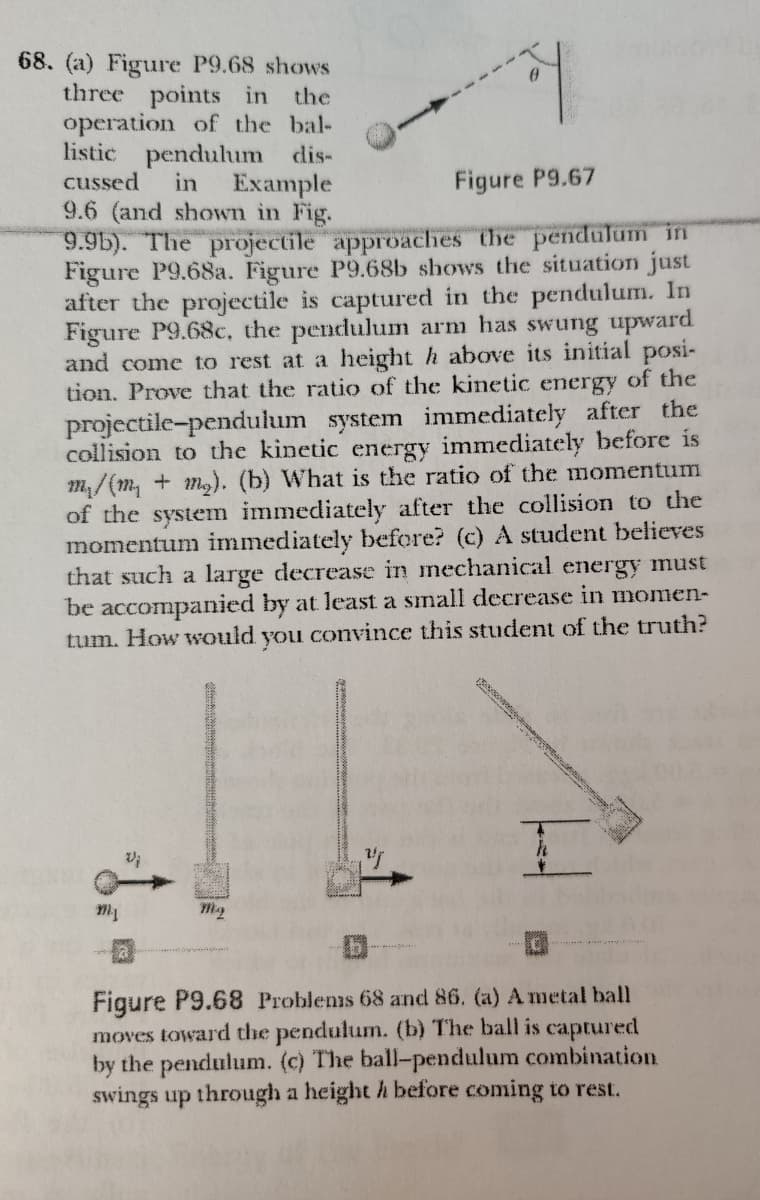68. (a) Figure P9.68 shows three points in the operation of the bal- listic pendulum dis- cussed in Example Figure P9.67 9.6 (and shown in Fig. 9.9b). The projectile approaches the pendulum in Figure P9.68a. Figure P9.68b shows the situation just after the projectile is captured in the pendulum. In Figure P9.68c, the pendulum arm has swung upward and come to rest at a height h above its initial posi- tion. Prove that the ratio of the kinetic energy of the projectile-pendulum system immediately after the collision to the kinetic energy immediately before is m,/(m, + m,). (b) What is the ratio of the momentum of the system immediately after the collision to the momentum immediately before? (c) A student believes that such a large decrease in mechanical energy must be accompanied by at least a small decrease in momen- tum. How would you convince this student of the truth? Figure P9.68 Problens 68 and 86. (a) A metal ball moves toward the pendulum. (b) The ball is captured by the pendulum. (c) The ball-pendulum combination swings up through a height h before coming to rest.
68. (a) Figure P9.68 shows three points in the operation of the bal- listic pendulum dis- cussed in Example Figure P9.67 9.6 (and shown in Fig. 9.9b). The projectile approaches the pendulum in Figure P9.68a. Figure P9.68b shows the situation just after the projectile is captured in the pendulum. In Figure P9.68c, the pendulum arm has swung upward and come to rest at a height h above its initial posi- tion. Prove that the ratio of the kinetic energy of the projectile-pendulum system immediately after the collision to the kinetic energy immediately before is m,/(m, + m,). (b) What is the ratio of the momentum of the system immediately after the collision to the momentum immediately before? (c) A student believes that such a large decrease in mechanical energy must be accompanied by at least a small decrease in momen- tum. How would you convince this student of the truth? Figure P9.68 Problens 68 and 86. (a) A metal ball moves toward the pendulum. (b) The ball is captured by the pendulum. (c) The ball-pendulum combination swings up through a height h before coming to rest.
Physics for Scientists and Engineers
10th Edition
ISBN:9781337553278
Author:Raymond A. Serway, John W. Jewett
Publisher:Raymond A. Serway, John W. Jewett
Chapter9: Linear Momentum And Collisions
Section: Chapter Questions
Problem 36AP: (a) Figure P9.36 shows three points in the operation of the ballistic pendulum discussed in Example...
Related questions
Question

Transcribed Image Text:68. (a) Figure P9.68 shows
three points in the
operation of the bal-
listic pendulum dis-
cussed
in
Example
Figure P9.67
9.6 (and shown in Fig.
9.9b). The projectile approaches the pendulum in
Figure P9.68a. Figure P9.68b shows the situation just
after the projectile is captured in the pendulum. In
Figure P9.68c, the pendulum arm has swung upward
and come to rest at a height h above its initial posi-
tion. Prove that the ratio of the kinetic energy of the
projectile-pendulum system immediately after the
collision to the kinetic energy immediately before is
m, /(m, + m). (b) What is the ratio of the momentum
of the system immediately after the collision to the
momentum immediately before? (c) A student believes
that such a large decrease in mechanical energy must
be accompanied by at least a small decrease in momen-
tum. How would you convince this student of the truth?
My
Figure P9.68 Problens 68 and 86. (a) A metal ball
moves toward the pendulum. (b) The ball is captured
by the pendulum. (c) The ball-pendulum combination
swings up through a height h before coming to rest.
Expert Solution
This question has been solved!
Explore an expertly crafted, step-by-step solution for a thorough understanding of key concepts.
This is a popular solution!
Trending now
This is a popular solution!
Step by step
Solved in 4 steps

Knowledge Booster
Learn more about
Need a deep-dive on the concept behind this application? Look no further. Learn more about this topic, physics and related others by exploring similar questions and additional content below.Recommended textbooks for you

Physics for Scientists and Engineers
Physics
ISBN:
9781337553278
Author:
Raymond A. Serway, John W. Jewett
Publisher:
Cengage Learning

Physics for Scientists and Engineers with Modern …
Physics
ISBN:
9781337553292
Author:
Raymond A. Serway, John W. Jewett
Publisher:
Cengage Learning

Physics for Scientists and Engineers: Foundations…
Physics
ISBN:
9781133939146
Author:
Katz, Debora M.
Publisher:
Cengage Learning

Physics for Scientists and Engineers
Physics
ISBN:
9781337553278
Author:
Raymond A. Serway, John W. Jewett
Publisher:
Cengage Learning

Physics for Scientists and Engineers with Modern …
Physics
ISBN:
9781337553292
Author:
Raymond A. Serway, John W. Jewett
Publisher:
Cengage Learning

Physics for Scientists and Engineers: Foundations…
Physics
ISBN:
9781133939146
Author:
Katz, Debora M.
Publisher:
Cengage Learning

College Physics
Physics
ISBN:
9781305952300
Author:
Raymond A. Serway, Chris Vuille
Publisher:
Cengage Learning

Principles of Physics: A Calculus-Based Text
Physics
ISBN:
9781133104261
Author:
Raymond A. Serway, John W. Jewett
Publisher:
Cengage Learning

Physics for Scientists and Engineers, Technology …
Physics
ISBN:
9781305116399
Author:
Raymond A. Serway, John W. Jewett
Publisher:
Cengage Learning